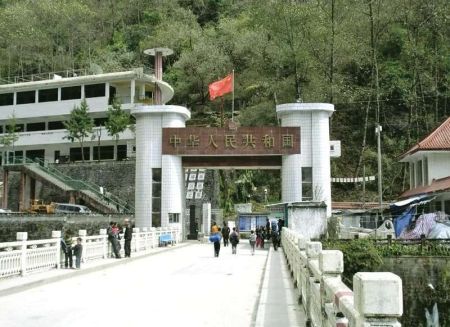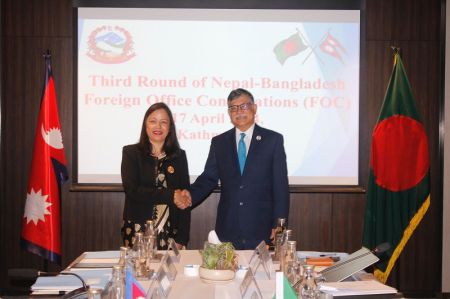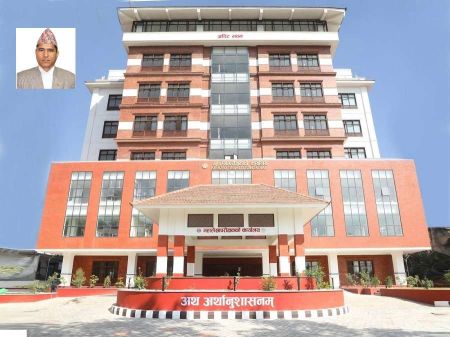| “Cement industry has immense scope”
What is the situation of cement industry in Nepal? The cement industry in Nepal is in the growing phase. Nepal is in the initial phase of infrastructural development. There are about 40-50 cement industries in existence in the country. The cement industry has immense scope. What are the problems faced by the Nepali Cement Industry? How can they be addressed? One of the major problems is load shedding. The labour problem is another problem in remote areas. Besides Birgunj, our two factories are in Rolpa and Abukhaireni where we find difficulty in getting labour as required. Most of the cement factories are established in the remote part of the country and lack of manpower in the remote areas creates the labor problem in the cement industry. In fact, both skilled and unskilled manpower are lacking in Nepal. We expect that the government should address the problem of load shedding in industrial area. For labour, we are hiring labour through a contractor. As the cement industries are creating employment opportunities within the country, Nepalis can do better in their own country rather than trying for foreign employment. How is the competition in the market? How are you facing it? There are a number of cement factories in Nepal and competition is inevitable. But considering the demand of the market, there is not such competition because the demand is higher than the supply. What are your promotion plans? We are using both print and electronic media to promote our products. We are also using social media for the promotion of our product. What do you expect from government to facilitate the Nepali cement industry? The government should address the electricity, infrastructure and labour problems. Also, the local communities’ problems arising in the industrial areas need to be addressed. The government should create the environment to do business in an easy way to encourage more investors in the cement industry. Then, after meeting the domestic demand, we can think of exporting cement. What are USPs/features of Advance cement? We have three companies of cement; Araniko Cement Industry, Abukhaireni Cement Industry and Rolpa Cement Industry under one brand that is Advance cement. We have Advance PPC, OPC and PLC that we recently launched. We provide quality products at competitive price in the market. We try to reach our customers with reasonable price and quality. What is the prospect of foreign investment in Nepali cement industry? As mentioned above, Nepal is in the initial phase of development and is growing very fast. Foreign investment in the industrial sector is positive. It can bring lots of opportunities, competition, and employment too. Foreign investment can help in the production of quality products by introducing new technologies. They will also provide better management and technical support to Nepali industries and provide other various benefits. What is the possibility of cement export? First, we have to meet our own domestic demand. We are situated between two big neighbouring countries China and India. So, there is a good chance of exporting cement. What is the capacity of Advance cement? Our Jitpur, Abukhaireni and Rolpa plants are producing 500 tons of cement a day. The Rolpa plant is of clinker unit and next two plants are grinding units. We are running our company independently. |
| “There is possibility of foreign investment in cement industry”
How is the cement industry doing in Nepal? The situation of the cement industry is progressive. Investment in the industry is increasing. What is important is these investments are being made mostly in the rural areas. There is also possibility of foreign investment in the cement industry. A lot more can be done. What was the motivation for starting cement production by Keyal group? We have been producing cement for the last one decade. Not only cement, Keyal group is producing other construction materials too. The experience we got from importing cement motivated us to produce cement within the country. The increasing demand of cement in the domestic market has encouraged us to produce cement. We are producing Arati PSC, Shikhar OPC and Camel brands of cement from our Star Cement Industry. How is the competition in the market? How is Keyal group facing it? The main character of open market and free economy is competition. Competition should exist as consumers get option to choose for quality and price which ultimately help in the promotion of technology and quality products. Competition not only benefits the consumers but also the industry. We are focused on quality. Our three brands are certified with Nepal Standard (NS). Our commercial aim is to provide quality cement at reasonable price to our consumers. Our value is to not to compromise in quality and our first priorities are consumers and big projects. What are your future plans? We are planning to increase the production capacity of our plant in the near future. Our brand has reached the eastern, central and western part of the country. We are also planning to expand our products; reach to the mid- and far-western regions of Nepal. The increase in development and construction work ultimately increases the demand of cement in the market. We are also planning to export cement to India in the future. What are the problems faced by the Nepali cement industry? The unstable political and economic situation has affected the cement industry like it has affected other businesses and industries. There is not enough investment in this sector as the development of physical infrastructure is yet to take the desired pace. The lack of electricity is also a major problem. The production cost has gone up due to daily load shedding of 15 hours. There is also the problem of roads for the transportation of raw material and finished product. The government has failed to spend the development budget. The construction work has been slow. It has affected the production of construction materials. There is lack of investment in the housing industry that has also affected the cement industry. What should Nepal do to be self-reliant in cement? Nepali has become self-reliant in cement in terms of the production capacity of the cement factories currently operational. However, the factories have been able to utilize only half of their production capacity. The major chunk of clinker, an important raw material for cement, is being imported from India. We have to import other raw materials too. There are still some policy-related problems. The government has asked the domestic cement factories to be self-reliant on clinker within five years of the establishment of the factory. But the government has not been able to provide the required infrastructure such as electricity and roads for that to happen. More than two-thirds of the capital used in the production of cement is spent for the production of clinker. So, if the government does not encourage investment in the cement industry, most of the factories except a few will face difficulties. Also, if the government can facilitate low-interest loan, it will be very much effective. |
| “We hope to be self-reliant in clinker within the next three years”
What is the number of operational cement factories in Nepal? There are around 45 cement factories operational in the country at present. What is their combined production capacity? Our total production capacity is around 6-7 million metric tons annually; it’s more than the demand. But only around half of this production capacity is being utilized at present. How many factories are producing clinker, a major raw material for cement production? There are 12 factories producing clinker. Almost 60 per cent of the annual clinker demand in Nepal is met through domestic supply. Few clinker manufacturing plants are under construction. We hope to be self-reliant on clinker as well within the next three years. We have already become self-reliant on cement in term of the production capacity of the cement factories. However, cement is also being imported because, as I said earlier, on average, we have been able to utilize only half of our total production capacity. Why is the cement imported from India cheaper than Nepali cement? General consumers are not importing cement from India. It’s the big infrastructure projects run through the international competitive bidding (ICB) process that are importing cement from India. In the ICB contract, it is mentioned that the construction materials to be imported will not be taxed. So, the imported cement gets an exemption of Rs 185 per sack in customs duty. That is why it is cheaper. It has affected the Nepali cement market. If the cement imported from India did not enjoy tax exemption, we would have been self-reliant on cement. Currently, only about 80 per cent of the demand is met through domestically produced cement; the remaining 20 per cent is imported. Is the tax exemption still relevant? No, it is not. Ten years ago maybe it was as the domestic supply of cement would not meet the demand and cement had to be imported. If customs duty was levied on the imported cement, the project cost would rise. So, while signing the assistance agreement with multilateral donor agencies like the Asian Development Bank and World Bank and international contractors, the government would agree to provide exemption on customs duty while importing construction materials. But today, there are enough cement factories in Nepal itself. If the government can provide continuous electricity supply, these factories can meet the entire annual national demand of cement. The tax exemption has not benefitted the government. It may have helped in lowering the project cost but the government is losing revenue. So, we have been requesting the government to start levying customs duty on imported cement. What is the situation of employment in the cement industry? The cement industry has provided direct employment to around 12,000 people. But the indirect employment is more than 10 times more than the direct employment. That’s why the cement industry plays a major role in the overall economic activities. How has the demand of cement been growing? The demand has been growing at 8-10 per cent per annum. However, the demand registered a negative growth two years ago because of the problems seen in the real estate and housing sector. But if you take an average of the last one decade, it has been growing. The consumption of cement is a direct indicator of infrastructure development in any country. For a country like Nepal to achieve fast economic growth, the annual demand of cement has to grow at 20 per cent per annum. Economic development is not possible without infrastructure development. Similarly, sustainable peace is not possible without economic development and political stability is not possible without sustainable peace. So, cement plays an important role in the establishment of sustainable peace and political stability. But the good thing is, the import of cement has been declining year on year. Five years ago, 50 per cent of the domestic demand of cement was met through imports; today it has come down to 20 per cent. How is the quality of Nepali cement? Nepali cement is of international standard in term of quality. However, what one needs to understand is that there are various types of cement and their quality or standard varies. But the Nepal Bureau of Standards and Metrology (NBSM) has set a single standard i.e. the Nepal Standard (NS) for cement. One cannot sell cement in Nepal without acquiring the NS. We need cements of varying standard, depending on the nature and type of the construction work. So, there is demand for cements of various standards. But NBSM doesn’t seem to have accepted this fact. That’s why we have requested NBSM to fix the standards of various types of cement so that there are cements of various standards, not just one standard. NBSM has taken our suggestion positively and has started homework regarding this. The import of clinker, too, has been declining significantly. Hasn’t it? Yes, the import of clinker has been declining. Ten years ago, Nepal used to import all the clinker it needed. Today, it imports only 40 per cent; 60 per cent of clinker demand is met through domestic means. The import might come down to 20-25 percent in the next year as a couple of new factories will start manufacturing clinker. As I said earlier, clinker import will come down to zero within the next three years. It is said that the competition in the domestic cement market is not healthy. Why? The total production capacity of the cement factories operational in the country at present is twice the annual demand. Besides, it is a seasonal business. Cement demand declines in the rainy season and increases in the dry season. But cheaper electricity is available during the rainy season. It also decreases the production cost. So, the production doesn’t decrease during the rainy season though the demand decreases. What do you do in a situation when the production is high but the demand is low? Obviously, you decrease the price as far as possible. Sometimes, you may have to sell it at a break-even price. But in the dry season, the production is low because of the long hours of load-shedding but the demand is high. So, cement manufacturers get a comparatively bigger profit margin. We have a free market where demand and supply rule the price. This is fair enough. I don’t call it unhealthy competition. What are the chances of foreign investment in Nepali cement industry – last year, Nigerian cement giant Dangote announced to invest USD 800 million in a cement plant in Nepal and recently we heard that some Chinese investment is also coming? We, too, have been hearing about these developments. However, I don’t think the current situation is favourable for foreign investment in cement. Foreign investment is necessary for a large-scale industry. The cement factories in Nepal are not very big. They are small plants in term of production capacity compared to the global trend. We don’t have physical infrastructures such as roads to support a huge cement factory. Similarly, the electricity supply is not adequate. Also, there are enough cement factories in the country already. So foreign investment in cement is not / should not be a national priority at the moment. What is the current annual demand of cement? It is about 4 million metric ton of which some 3.2 million metric ton is met through domestic production and the rest is imported. What is the prospect of exporting cement from Nepal? There is potential for exports but our production cost is high compared to other countries. The price of cement is highest in Nepal in entire South Asia. What are the major problems faced by the cement in Nepal, apart from the power crisis? Power crisis is the major problem. The government has promised to supply electricity to all cement factories. But this hasn’t been possible. Recently, Rolpa cement factory was closed down because of lack of electricity, Similarly, the government has promised to build roads linking mines and factories to the market. But there are problems regarding fulfilling this promise too. Besides these, there are some socio-political problems. There is a long chain of events behind cement production – limestone is extracted from mines in remote villages and the finished product is sold, mostly, in urban areas like Kathmandu, Biratnagar, Birgunj etc. Small social problems are politicized. Cement industries have to pay taxes at 3-4 layers – royalties to VDC, DDC etc and income tax etc. |
| “Maruti cement has become the country’s Number One cement”
Maruti Cement Limited (MCL) an ISO 9001:2008 and 14001:2004 certified company is producing and distributing Ordinary Portland Cement (OPC) regularly for the past eight years. Maruti cement has become the first choice of the customers. The cement is being used for infrastructural development like roads, dams, and housing and also for building homes. It is also being used in the construction of big projects in Nepal. Such projects include Himal Hydropower, Mid Hill Highway and Bridge Project, CE Construction, Grande International, Down Town Apartment, CG Properties, Kohinoor Hill Housing, Classic Developers, Kalika Construction, Tundi Construction, Panchakanya Ready Mix, MAW Ready Mix, etc. Also Maruti OPC cement is used in the major projects of the country and it is due to the strong base of trust that MCL has created in the hearts and minds of engineers, contractors and the public. The clear and far sited vision of work plan of Maruti Cement Company and the dedicated and skilled manpower have made it a quality product. We use the limestone of our own mine to produce a high quality clinker. We have our Greenfield Plant with international standard rotary technology; we have met the standard set by the government. And that is why the cement is successful to become the No. 1 cement of the country. |
| “We are confident of our brand”
How is the country’s cement industry doing? Compared to the past, the situation of cement industry has been pleasant in recent days. Cement factories are being established in various parts of the country and increasingly meeting the national demand. In short, the cement industry is headed for becoming one of the prominent industries in Nepal. What are the problems faced by the Nepali Cement Industry? How can they be addressed? No doubt, the major problem is the lack of adequate electricity. The government has imposed high customs duty on the import of raw material. There are also problems related with the availability of labour, hindering the smooth operation of the industry. Nepali industries are facing lots of problem at every step and it is not easy to exist. The government should provide the required services and facilities. Cement factories, on their part, should meet the standard set by the government. The government should provide regular power supply to the factories. The competition in the cement market is said to be tough. How are you facing it? The business of cement is totally dealers oriented as they are selling only those products which give them a good profit. The lack of a grading system for cement is creating confusion to the customers looking for quality product. The factories producing raw material (clinker) in the country are selling it at a higher cost and selling cement at a lower cost. So it is hard to compete in the market. What are your promotion plans? Our main motto is to provide quality product to the customers. If we do not ensure quality, we cannot get a place in the hearts and minds of the customers and cannot compete in the market. We are making customers aware about our brand through different media from time to time. Ambe Cement is one of the well-established brands in the country. What do you expect from government to facilitate the Nepali cement industry? The import of cement has drastically decreased due to the increasing production in the country. So the government should facilitate the industry by creating appropriate physical infrastructure like electricity, roads, etc as soon as possible so that it would be easy for the proper functioning of the industry. What are USPs of Ambe cement? We are confident of our brand. We do not compromise with the product’s quality and cost. We deliver our product at the construction site on time. What prospects do you see for foreign investment in the Nepali cement industry? There is possibility of foreign investment. We also have heard about the entry of foreign investors. To attract foreign investment, the government should create a stable environment for investment and should provide physical infrastructures. The government should secure the investment made in the domestic cement industry and provide all essential infrastructures requirement. This will automatically attract foreign investors. What is the possibility of cement export? As we are not being able to fulfill the domestic demand, there is no possibility of export currently. Most factories are selling their products within the country. We can think of exports once we meet the domestic demand. How is Ambe cement operating? We are importing raw materials. We are in the process to start manufacturing our own clinker. |
| “We are confident of our brand”
What are the special features of Kalash Gold PPC cement? We have been manufacturing cement for the past one decade. Kalash Gold PPC is the only rust-proof Nepali cement. This is the main specialty of this cement. The use of this cement protects the iron rods and other construction material from rust. Therefore, any construction made with Kalash Gold is stronger and sustainable. We have not compromised with quality. Our product has already received the Nepal Standard (NS) certificate. This is high quality cement manufactured through the use of modern technology. The consumers are using this cement because of its quality which has made it possible to face the competition in the market. What are the future plans of your factory? We are going to manufacture Kalash brand of OPC cement in the near future. We have already completed the process to receive NS certificate. We are ready to start producing OPC cement as soon as we get the certificate. We also have the plans to manufacture clinker as well. The process to acquire a limestone mine has moved forward. The investment in the cement industry has been growing year on year. This means there is tough completion in the market. Isn’t it? Competition is natural. There is always competition in the open market. The positive aspects of competition are beneficial to both producers and consumers. But sometimes, we see unhealthy competition in the market which is not good. When there is unhealthy competition, the producers have to take a great risk. There should be competition in the quality of cement. In the past, one could manufacture cement even without taking the NS certificate. It is not possible to do so now. NS certificate is a must for producing cement. At present, the supply is more than the demand. Such a situation needs to be improved. You have been producing cement for a long time. How has the Nepali cement industry evolved over these years? The cement industry has great possibilities as the production, marketisation and consumption takes place within the country. Until a few years ago, the domestic production of cement would not meet even 20 percent of the demand. Cement supply in the country was based on imports. Today, domestic production meets about 80 percent of the annual demand. Investment in the cement industry has been increasing. This has been possible because of possibilities. There are talks about foreign investment in the cement industry. This is positive. Prospects for the cement industry will be even brighter if infrastructure development and construction catches speed. There must be some problems faced by the cement industry. What are they? At a time when the entire economy is in confusion because of the lack of political stability, you don’t expect the cement industry to be different. As the government hasn’t been able to make capital expenditure as expected, the speed of infrastructure development and construction is quite slow. This has affected the cement business in the country. Power crisis is another problem. The government hasn’t been able to develop essential infrastructures such as roads connecting the cement factories with the market. Most of the cement factories import raw material. Nearly 95 percent factories are limited to grinding units. The product has become expensive because of the customs duty levied on the imported raw material. The government has stated to displace clinker import. When will that be possible? The government has stated to displace clinker import by producing the raw material within the country. If we can become self-reliant on cement, that will be good for the manufacturers, consumers and state. This sounds sweet to the ear but it is challenging. We lack appropriate policies as well as infrastructure. Lack of transparency in mine exploration and excavation is a major hurdle to Nepal becoming self-reliant in cement. Clinker production means more investment. More than 70 percent of the investment goes for clinker production. So, mere announcements are not enough. We need a supporting strategy as well. |
| “We are in the process of exporting cement to India”
Chachan Group has been increasing investment in cement production. How is the situation of the cement industry in Nepal? The situation is progressive and moving in positive direction. Investors are excited about their investments in the cement industry. The increase in development and construction works has increased the consumption of cement in the country. We have 11 years of experience of cement production. Recently, we established another cement plant, Jay Bageshwari Cement Pvt. Ltd. with the investment of Rs. 500 million in Nepalgunj. Currently we are producing 1050 metric tons of cement from the three plant. We are producing Trishakti Premium in OPC and Trishakti Super and Bajra Shakti in PPC categories. There is stiff competition in the cement market. How you are facing the competition? Healthy competition based on quality is good for the industry. It has been encouraging cement producers to increase production capacity and generating ideas to bring quality products in the market. But there is some unhealthy competition in the market as well. Some manufacturers of low quality cement are confusing the consumers through advertisements. None of the product gets established in the market without competition. We compete in the market with our quality product, as our product is already well known. We have won the trust of our customers. We do not compromise with quality. Quality is only mantra for success for us. You said there is some unhealthy competition in the market. What are the special features of your cement? Chachan group is an ISO 9001:2008 and 14001:2004 certified company. All our brands have received the Nepal Standard (NS) certificate. We produce cement using close circuit and PLC technology at Nepalgunj factory that produces stable and high quality cement. We are also in the process to acquire Bureau of Indian Standards (BIS) certificate to export cement to India. We are producing cement which is of international standard. What are the problems faced by the domestic cement industry? How can they be addressed? Political instability is the main hindrance. Electricity crisis is another big problem which every industry is facing. Also the unfavorable environment, lack of manpower and infrastructure and the problems related with the local community are creating obstacles from time to time. There is also the problem on unstated syndicate system in transportation. The cement factories are affected as the development and construction work has not taken the expected speed. There will be more investment in the cement industry if development and construction works gain momentum. The government should provide tax concession on the import of raw materials. Also the industry should be declared a strike-prohibited area. What are your further plans? In the near future, we will increase the production capacity of our Nepalgunj factory. We are also planning exporting cement to India. We have bought limestone mine for the production of clinker. And we are in process to bring the PSC cement in Swastik brand. You are planning to produce clinker as well. What are the prospects? Nepal has enough limestone mines but these mines lack access to roads. This is the biggest problem being faced by the clinker factories. Some factories are producing clinker but the demand is still greater than the supply. The mines and factories should be linked to roads. There should be enough supply of electricity. The trend of occupying mines without any production should be ended in policy level that will make way for the production of clinker. |
| “Shivam cement has created its own brand image in a short period of time’’
What are the problems faced by the Nepali Cement Industry? Nepali cement industry’s major problem is load shedding. The lack of physical infrastructures such as roads is another main problem. This has created difficulties in the transportation of raw materials from limestone quarry site to the factory. It takes 2-3 years to get the Environment Impact Assessment (EIA) approved when anyone wants to increase the production capacity. This is not a favorable environment for the expansion of the capacity of the industry. The development of the country is almost impossible without the development of Nepali cement industry as cement is the basic and important material for infrastructure development. So, the government should guarantee to provide electricity 24 hours in the industrial area and approve the EIA within few months. We are hopeful that the government will address these problems as soon as possible. What about the competition in the market? How are you facing it? Our factory is located in the central part of the country, Hetauda. We excavate limestone of own mine to produce our own clinker. We produce world-class clinker and OPC brand Shivam cement using German technology. We ensure quality product to our customers and also provide after-sales technical support. Thus we remain in the hearts of the customers. The competition is definitely high as there are a number of cement factories. But we believe that healthy competition will bring quality products in the market. What are your promotional plans? We are planning to increase our production capacity up to 3000 metric tons per day within few years. In the long term, we are planning to produce 6000 metric tons per day. For this, we have already signed a joint venture agreement with one of the largest cement producing company of China, Hongshi Holdings Ltd. We are working on it so as to bring the joint investment production in 3 years. What are USPs/features of Shivam Cement? Shivam cement has created its own brand image in a short period of time. Our principle is that we never compromise with quality. We are providing employment opportunity to more than 2500 people directly and indirectly. Shivam cement solely has displaced the import of cement and clinker amounting billions of rupees. Contributing to the balance of payment positively, we are paying Rs 500 million in tax annually. The main features of Shivam cement is its quality. That is why, whether it would be big hydro power projects, bridges or commercial and individual housings, Shivam cement is the first choice of the people. Shivam Cement is being currently used in large scale national level projects such as Kathmandu Ring Road Expansion Project and Nepal Army Veterans and Civil Hospital. What is the prospect of foreign investment in Nepali Cement Industry? We have huge limestone deposits in our country. Proper utilization of the resources in an eco-friendly manner will definitely make significant contribution in country’s economic growth. We have huge prospect of foreign investment in the cement Industry. As mentioned earlier, Shivam Cement is bringing foreign investment to the country through joint venture agreement with Chinese cement producer, Hongshi Holdings Ltd. This will act as a source of motivation to other investors and we also believe that after successful completion of this project and significant progress, other foreign investments will be attracted too in Nepali cement Industry. |
| “We are the only brand in Nepal to use laminated sack”
What is the situation of cement industry in Nepal? The industry is in the blooming phase. After the 2006 April uprising, the development of Nepal has started. There is lot more to be done for infrastructural development like building roads, bridges, hydropower and irrigation projects. The increment of remittance in Nepal has started the trend in Nepalis people of building a small home of their own. And if we can grab the opportunity by converting the remittance in the infrastructure development as foreign investment has also been coming to Nepal, the future of cement is bright. In Nepal cement industry is only the one industry that is being successful in import displacement and is heading for the export business. What are the problems faced by the Nepali cement industry? How can they be addressed? Load shedding is the major problem that the industry is facing. For the making of cement clinker is needed which demands 1400 degree Celsius temperature and should be maintained throughout the month and if there cause interval then it will be hard to overcome. The price of cement will decrease in 10 percent less in now if there is not problem of electricity. In cement industry, it demands 24 hours electricity but we are running the industry by supplying 16 hours diesel generators which ultimately increases the price of cement. Nepal Electricity Authority (NEA) is providing power through dedicated feeder (supplying continues electricity for certain time) in the special projects and industry. If the dedicated feeder is supplied by NEA in all grinder units of the industry then it would be of very much helpful. How is the competition in domestic cement market? There is competition in the market. The cost price will decrease that much if we can transport from the nearby side of the factory. The aim is to sale the cement to the customer in reasonable prices by reducing the transportation charge. So to lessen the transportation charge cement factories are establishing in the different part of the country due to which the competition is high. How are promoting Jagdamba cement? Jagdamba cement is the first and the only industry in Nepal that manufactures OPC, PPC and PSC cement that are in use. To reach in the market in ease way, we have established our factories in Birgunj and in Bahairahawa. We also provide after sales service. We have our hotline opened for 24 hours for any kind of suggestion and feedback. We are providing information through different publication on the ways to use cement and also from our dealers. Also we are organizing training program for constructer like national meet, dealer meet, and special technical meet to provide knowledge and to gain more qualitative, strong and safer construction all over Nepal. We are using all kind of media, electronic and print media to promote our product and for awareness. And soon in the future we are launching mobile app service. What do you expect from government to facilitate the Nepali cement industry? As mentioned above, if government could provide regular power supply through dedicated feeder as like in some projects and the industries to all the industries then it would be very much supportive for the smooth operation and the development of overall industry. What are USPs of Jagdamba Cement? We are only one among other brand that has started the use of laminated sack to reduce the cement come out from it. We also provide after sale service by providing information and knowledge to apply the correct ways on which cement should be use on what kind of construction through different publication. We are more oriented in consumer awareness and consumer feedback. What is the prospect of foreign investment in Nepali cement industry? The cement industries that are established in Nepal are sufficient for the production. Nepal is rich in its natural resources. If political situation will be stable, more developmental work is possible as Nepal is rising the as the link between China and India. Foreign investments on different infrastructural development will ultimately endeavor in cement industry and can result for the prosperous development of the Nepal. |


.jpg)



























